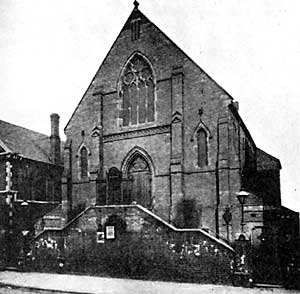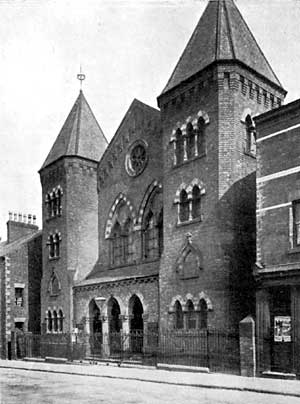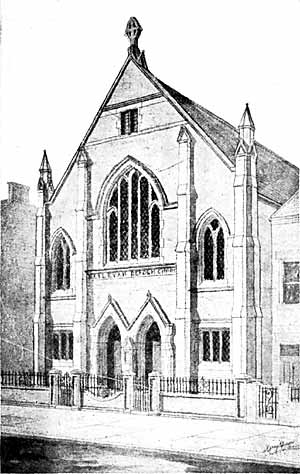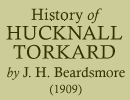< Previous | Contents | Next >
The rift in the Wesleyan body, which occurred at the close of the 18th century was perhaps responsible for the feebleness of the cause for a short period afterwards in this parish. A brief reference to Hucknall was made in the memoirs of that famous lady travelling Wesleyan preacher, Mrs. Mary Taft, who on page 163 of her "Memoirs," wrote of her visit here in A.D. 1800:—"I then returned into Notts, and saw evidence of good done at Hathcrn, Farnsfield, Edingley, Oxton, and Hucknall.''
The Wesleyans do not appear to have had a strong church in Hucknall in the early part of the 19th century. The first mention of a prominent member of the old Wesleyan body, after the New Connexion had separated therefrom, was in 1831, when Mr. Skevington, who lived at the Farleys, was stated to be a licensed Wesleyan local preacher. He was called as a witness at the trial of Thomas Smith, of Fern Cottage, Wood Lane, who was charged
with taking part in the Reform riots in Nottingham in 1831. Mr. Skevington, on January 12th, 1832, proved in the Assize Court that Smith was at work in a garden at the Farleys on the day when Nottingham Castle was fired. Smith was set free after Mr. Skevington's evidence had been given.
The early Wesleyans met for worship in a thatched house at the corner of Half Moon Yard, where two rooms were knocked into one. Here they were often maltreated by the roughs of the parish. Services were afterwards held in a cottage where dwelt the Misses Truman, the site of which is now occupied by the Byron's Rest Inn.
The first chapel was built and opened in 1846, in Chapel-street. Dr. Beaumont, a very prominent divine, was the preacher at the opening, and Mr. Joseph Howis had much to do with the successful carrying out of the scheme, aided by his good wife. The little church sustained a heavy loss when Mr. Joseph Jackson, of Linby (for many years superintendent of the Sunday School), was killed by the fall of a wall when he was demolishing one of the cotton mills which stood near the Grange at Papplewick. The leading members at this period were John Collins, Joseph Parsons, and George Taylor, of Hucknall, and Joseph Johnson and Francis Lancashire, of Linby.
The names of Wesleyan ministers who have preached in the old chapel are Revs. B. Slater, Samuel Dunn, George Taylor, John McBrear, James Loutitt, Topham, John Hartley, Samuel Coley, John Clay, John A. Armstrong, Jas. Carr, John H. Beach, Walker, Cuthbertson, Jones, John Rattenbury, and W. G. Beardmore. Among the local preachers who officiated were Messrs. Peter Howis (Hucknall), F. Stout and Hill, of Bulwell; H. Hopewell, Nottingham; Sterland and John Savage.

Wesleyan chapel.
In 1880 the present Wesleyan Chapel was built on Watnall Road at a cost of about £1,500 (excluding the value of the site), and this enterprise was greatly helped by Mr. Thomas H. Gray, who had a few years previously come to live at Linby. The Revs. A. Macauley and Charles Garrett preached at the opening services, the Rev. Morley Punshon being prevented by illness from taking part therein.
In 1882 the old chapel was sold to the Mission Society for £340.
There were nine members on the roll in 1850; in 1907 there were one hundred and ten members, and two hundred and eighty scholars.
The birth and development of this Society is an interesting study. A few Baptists are said to have met together in the year 1750, and again in 1770, but no society was then formed, and candidates for immersion had to go to Kirkby, where Mr. Geo. Hard-staff was working in 1785, until he was ordained pastor there in 1799, and in 1806 he came occasionally to his kinsman Simpson's house in Beardall Street to preach.
In 1819 two baptisms took place at Hucknall, the usual place for this rite being the Town Brook, in Baker Street, or in the Daws' Dam, off the present Station Street.
A house in the Bed Lion Yard was rented at £7 a year for services, and it is said Ben Gaunt, the prize-fighter, when a youth, acted as candle-snuffer here, but probably lie did not officiate very often. Open-air services were general about the year 1822, and at the south end of the town the Beardalls were earnest adherents of the cause, and services were held in a house near the Yew Tree Inn.
In 1827 a revival took place, and a large room in High Street, belonging to Mr. Bhodes, situate near the site of the London, City, and Midland Bank, was engaged to accommodate increasing numbers. This room was used up to the year 1835, and a Sunday School was opened there. In 1829 the first Sunday school collection amounted to 50 shillings.
The late William Calladine joined the society in 1827. Beuben Cale and Jonathan Wakefield, two very well-known Baptists, were received into membership at this period, when there were 16 members on the roll.
Land was bought in the Folly from Mr. Widdowson at about 1s. per yard, and a chapel, built by Mr. Holmes, of Bulwell, was opened in 1835, when there were about 20 members and 80 Sunday school scholars. Attached to the chapel building is a little graveyard, in which no burials have taken place since 1870.
The early preachers came from Nottingham Stoney-street Chapel, and among the names of local preachers who visited Hucknall were Wm. Richardson, Joseph Plowright, Joseph Shaw, and Aaron Martin. The Hucknall Society was attached to the mother church of Stoney-street till 1840.
In 1849 the membership was 80; in 1853 there were 81 members and 185 scholars; in 1857, 83 members; in 1868, 120 members and 260 scholars; in 1872, 138 members; in 1874, 179 members; in 1875, 204 members; in 1877, 252 members and 400 scholars; and to-day there are about 300 members and 600 scholars. In 1853 the chapel was enlarged and the side vestry built.
For many years the singing was accompanied by an orchestral band, led by Mr. Geo. Wagg, the carrier, who for forty years never missed a service, although his vocation as carrier kept him at work late on Saturday nights. Among the more prominent instrumentalists were Abraham and Luke Wagg and T. Tomlinson (fiddles), Zachariah Green (basso), F. J. Phelps (trombone), John Buck (ophecleide), W. Towle (cornet), George Rhodes (tenor), and John Plumb (flute).
Among the more prominent of the workers have been Charles Severn (beloved by the young), Jonathan Wakefield, William Calladine the younger, John Buck, Herbert Wakefield, George Betteson, W. Hodges, the Wagg, Cale, Mayfield, Beardall, and Butler families.

Baptist chapel.
The present chapel was built in 1876. William Calladine, John Buck, and George Betteson attended the sale of the Rev. Curtis Jackson's Watnall Road land at the Green Dragon Inn, and bought the site for £375, Mr. Calladine agreeing to take to it if the society refused to have it. The society accepted it, and the edifice, which is of the Italian Renaissance style (Veronese type), was built at a cost of about £4,000.
On the day the memorial stones were laid by Mr. Hinmers and Alderman Manning, the Mayor of Nottingham, the following were present, and it will be noticed how death has serried their ranks:—Revs. J. T. Almy, J. Wild, E, Holyoake, Medley, T. Goadby, H. Barker (Sutton), Messrs. J. Buck, G. Betteson, Charles and William Calladine, senior and junior, W. Stainforth, F. N. Ellis, Andrew Radford, W. and F. R. Booker (the architects), J. A. Munks, and D. Ritchie, the builders.
The Rev. J. Wild was appointed first resident pastor in 1870, at a salary of £40 per annum. He married a Hucknall lady and dwelt here three years, and then went to Ilkeston. He was the first resident Nonconformist pastor in Hucknall since 1659, when the Rev. Henry Holton, a Congregational minister, preached at the parish church.
At Christmas, 1873, the Rev. J. T. Almy, from the south country, who in his early days had been a seafaring man, was appointed pastor, and ministered here seven years. He came from Spurgeon's College, and was very energetic. He was followed by the Rev. W. Chapman, who stayed eight years in the pastorate, and was greatly respected. Mr. Chapman retired in September, 1888. Soon afterwards the Rev. T. Cutts, of Nottingham, responded to the call, and during his charge the society prospered greatly. He retired in 1908, after ministering at Hucknall just over 17 years. The Rev. T. Knight, from Chatteris, opened his Hucknall ministry in November, 1908. The Sunday schools, erected in 1882, were the first to be built in this district in modern style.
Friendly Societies for men and women were formed at the chapel early in the 19th century, and proved very useful.
 Wesleyan Reform chapel.
Wesleyan Reform chapel.In the year 1880 a number of Christian people who had been associated with the Salvation Army in Hucknall seceded from that body because they disagreed with the Building Trust arrangements made at the Army headquarters, and also because they desired to establish a Sunday school, a branch of work the Army had not then adopted in Hucknall.
Eleven men and women met at the first meeting and firmly resolved to form a little society. They were soon reinforced by others, and, calling their new body the "Gospel Mission," at once began to work on the Army lines as to street preaching and singing.
Among others who were in the forefront were Messrs. Thomas Gill, Joseph Hurst, Samuel Severn, and Mrs. Clarke, and remarkable earnestness was displayed by the little body of people.
A barn in West Street was soon secured for indoor services, and in 1882 the old Wesleyan Chapel in Chapel Street was bought for £340. In 1887 this building, called "The Mission Hall," was enlarged and renovated at a cost of £200.
About the year 1900 informal negotiations were opened with the Wesleyan Reformers, with a view of union with that branch of the great Methodist family, and in 1901 the Hucknall Gospel Missioners joined with and became a branch of the Wesleyan Reform Church.
Earnest work and devotion resulted in continued increase of membership and numbers of Sunday scholars, so that the work became cramped for lack of room, and in 1898 a plot of land fronting to Annesley Road was bought for £330. A spacious chapel designed to seat 555 worshippers, and schoolrooms for 350 scholars, were built at a cost of nearly £3,000.
There are now (A.D. 1908) 180 members and about 300 scholars, in addition to 60 young men and women in the Bible Classes.
